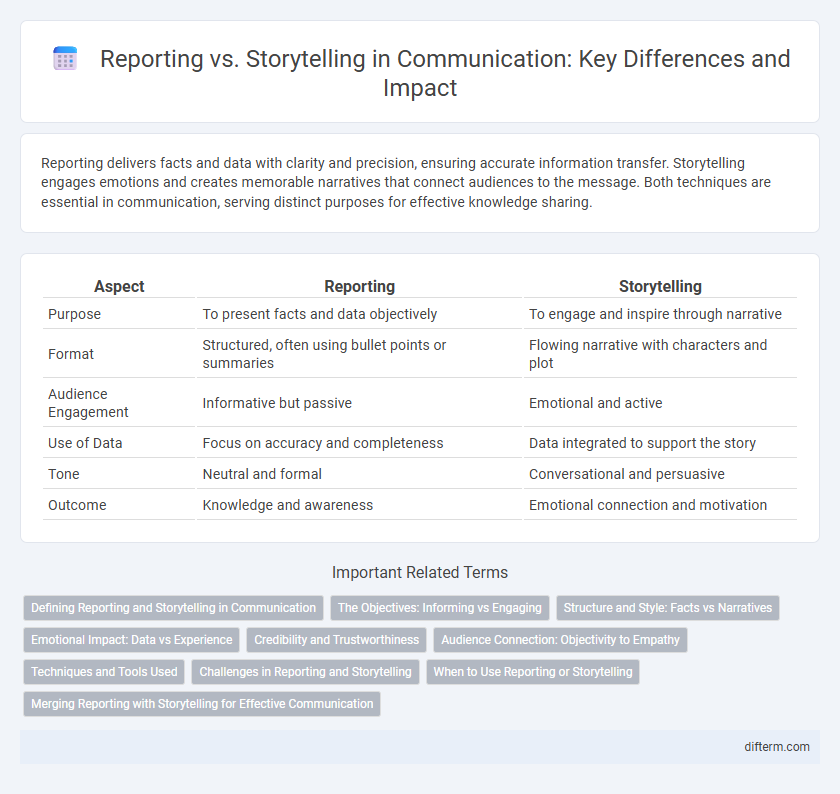Reporting delivers facts and data with clarity and precision, ensuring accurate information transfer. Storytelling engages emotions and creates memorable narratives that connect audiences to the message. Both techniques are essential in communication, serving distinct purposes for effective knowledge sharing.
Table of Comparison
| Aspect | Reporting | Storytelling |
|---|---|---|
| Purpose | To present facts and data objectively | To engage and inspire through narrative |
| Format | Structured, often using bullet points or summaries | Flowing narrative with characters and plot |
| Audience Engagement | Informative but passive | Emotional and active |
| Use of Data | Focus on accuracy and completeness | Data integrated to support the story |
| Tone | Neutral and formal | Conversational and persuasive |
| Outcome | Knowledge and awareness | Emotional connection and motivation |
Defining Reporting and Storytelling in Communication
Reporting in communication involves the clear, factual presentation of information, emphasizing accuracy and objectivity to convey data or events without interpretation. Storytelling, by contrast, uses narrative techniques to engage audiences emotionally, creating meaning through characters, plots, and context that enhance message retention and impact. Effective communication balances these methods to inform while captivating the audience, ensuring clarity and resonance.
The Objectives: Informing vs Engaging
Reporting aims to deliver clear, accurate information focused on facts and data to inform the audience efficiently. Storytelling seeks to engage emotions and imagination, creating a narrative that resonates and fosters a deeper connection. The primary objective of reporting is clarity and precision, whereas storytelling prioritizes engagement and emotional impact.
Structure and Style: Facts vs Narratives
Reporting relies on a structured format emphasizing factual accuracy, clarity, and objectivity, presenting data and events in a concise manner. Storytelling embraces a narrative style that weaves facts into engaging plots with characters, emotions, and context to captivate the audience. While reporting prioritizes straightforward information delivery, storytelling enhances understanding and retention through immersive and relatable experiences.
Emotional Impact: Data vs Experience
Reporting presents data and facts with clarity and precision, appealing to logic and rational analysis. Storytelling, however, leverages emotional impact by weaving personal experiences and relatable narratives, fostering deeper audience connection and empathy. Emotional consequences from storytelling often drive engagement and retention more effectively than straightforward data reporting.
Credibility and Trustworthiness
Reporting relies on factual accuracy and verifiable data to establish credibility, ensuring information is presented objectively without bias. Storytelling enhances trustworthiness by engaging emotions and providing context, which helps audiences connect with and remember the message. Combining transparent reporting with authentic storytelling builds stronger relationships based on both evidence and empathy.
Audience Connection: Objectivity to Empathy
Reporting delivers facts with objectivity, prioritizing accuracy and neutrality to inform the audience. Storytelling engages through empathy, weaving emotions and personal experiences that resonate deeply with listeners. This approach fosters stronger audience connection by transforming information into relatable narratives.
Techniques and Tools Used
Effective reporting relies on clear data visualization tools such as charts, graphs, and dashboards to present factual information concisely. Storytelling techniques use narrative structures, emotional appeals, and multimedia elements like videos and images to engage the audience deeply. Combining software like Tableau for reporting and platforms like Canva or Adobe Spark for storytelling enhances message delivery by tailoring communication methods to the content's purpose.
Challenges in Reporting and Storytelling
Challenges in reporting include maintaining accuracy and objectivity while presenting complex information clearly. Storytelling faces difficulties in engaging audiences emotionally without compromising factual integrity. Balancing informative content with compelling narratives requires strategic communication skills and careful editorial judgment.
When to Use Reporting or Storytelling
Reporting should be used when clear, factual information and data need to be conveyed quickly and accurately, such as in business updates or financial summaries. Storytelling is more effective when engaging an audience emotionally, making complex concepts relatable, or driving behavioral change, often utilized in marketing campaigns or leadership communication. Choosing between reporting and storytelling depends on the communication goal, audience needs, and the desired impact.
Merging Reporting with Storytelling for Effective Communication
Merging reporting with storytelling enhances communication by transforming raw data into compelling narratives that engage audiences and improve information retention. Incorporating storytelling techniques such as character, emotion, and context within structured reports helps clarify complex data and highlights key insights more memorably. This integrated approach fosters better understanding, drives emotional connection, and supports informed decision-making across diverse communication channels.
reporting vs storytelling Infographic

 difterm.com
difterm.com